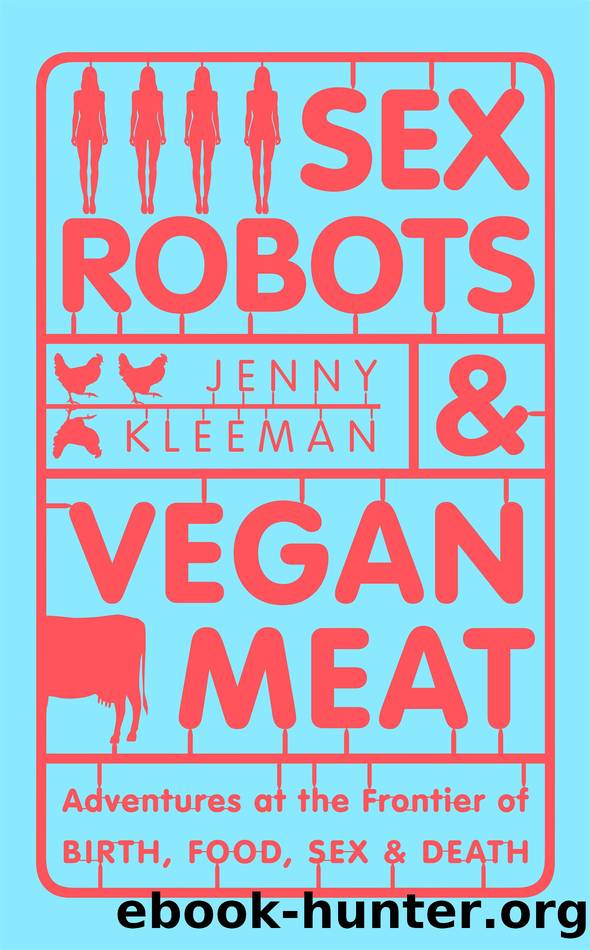Sex Robots & Vegan Meat by Jenny Kleeman

Author:Jenny Kleeman
Language: eng
Format: epub
Publisher: Pan Macmillan UK
CHAPTER TEN
The Biobag
The lamb is sleeping. It lies on its side, eyes shut, ears folded back and twitching. It swallows, wriggles and shuffles its gangly legs. Its crooked little half-smile makes it look particularly content, as if dreaming about gambolling in a grassy field somewhere. But this lamb is too tiny to venture into the outside world. Its eyes cannot open. It is hairless; its skin gathers in pink rolls at the base of its neck. It hasn’t been born yet, but here it is, at 111 days’ gestation, totally separate from its mother or any other animal, alive and kicking in a research lab in Philadelphia. It is submerged in fluid, floating inside a transparent plastic bag, with its umbilical cord connected to a nexus of bright blood-filled tubes. This is a foetus growing inside an artificial womb.
Here it is, two weeks later, at 135 days’ gestation, almost full term. The lamb nearly fills the entire space; its flat nose presses up against the corner of the bag. It is plumper, whiter, fluffier, covered in fine coils of wool, with a puff of a tail: definitely a lamb now, but still a foetus. In another two weeks, the Ziploc bag will be unzipped, the umbilical cord will be clamped and the lamb will finally be born.
When I first see images of the lamb in the bag on my laptop, I think of the foetus fields in The Matrix, where motherless babies are horrifically farmed in pods on an industrial scale: human Cowschwitz. But this is not a substitute for full gestation. California’s booming surrogacy industry can rest easy, for now. The Philadelphia lambs didn’t grow in the bags from conception; they were taken from their mothers’ wombs by caesarean section and then almost immediately submerged in the biobag at a gestational age equivalent to around twenty-three to twenty-four weeks in humans. This isn’t a replacement for pregnancy yet, but it is certainly the beginning of it. Birth may one day be as simple as opening a Ziploc bag.
The team who made these artificial wombs say they are driven only by the desire to save the most vulnerable humans on earth. Emily Partridge, Marcus Davey and Alan Flake are neonatologists, developmental physiologists and surgeons who work with extremely premature babies at the Children’s Hospital of Philadelphia (CHOP). After three years of tweaking and refinement, their latest prototype – ‘the biobag’ – is designed to give babies born too soon a greater chance of survival than ever before.
The biobag was born into public consciousness in April 2017, when the CHOP team published their research, along with images of the lambs, in the journal Nature Communications. The paper describes the four different artificial womb prototypes CHOP tested on a total of twenty-three lambs before settling on the biobag design. (Sheep are the go-to animal models in obstetric research because they have a long gestation period, and their foetuses are around the same size as ours.)
‘In the developed world, extreme prematurity is the leading cause of neonatal mortality and morbidity,’ the paper begins.
Download
This site does not store any files on its server. We only index and link to content provided by other sites. Please contact the content providers to delete copyright contents if any and email us, we'll remove relevant links or contents immediately.
Machine Learning at Scale with H2O by Gregory Keys | David Whiting(4258)
Never by Ken Follett(3878)
Fairy Tale by Stephen King(3306)
Will by Will Smith(2872)
Hooked: A Dark, Contemporary Romance (Never After Series) by Emily McIntire(2527)
The Dawn of Everything: A New History of Humanity by David Graeber & David Wengrow(2155)
The Becoming by Nora Roberts(2148)
HBR's 10 Must Reads 2022 by Harvard Business Review(1820)
The Strength In Our Scars by Bianca Sparacino(1817)
A Short History of War by Jeremy Black(1815)
Go Tell the Bees That I Am Gone by Diana Gabaldon(1730)
A Game of Thrones (The Illustrated Edition) by George R. R. Martin(1660)
515945210 by Unknown(1642)
Bewilderment by Richard Powers(1577)
443319537 by Unknown(1520)
The 1619 Project by Unknown(1434)
The Real Anthony Fauci: Bill Gates, Big Pharma, and the Global War on Democracy and Public Health (Childrenâs Health Defense) by Robert F. Kennedy(1383)
How to Live by Derek Sivers(1335)
Works by Richard Wright(1312)
